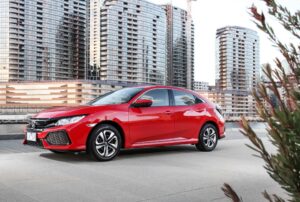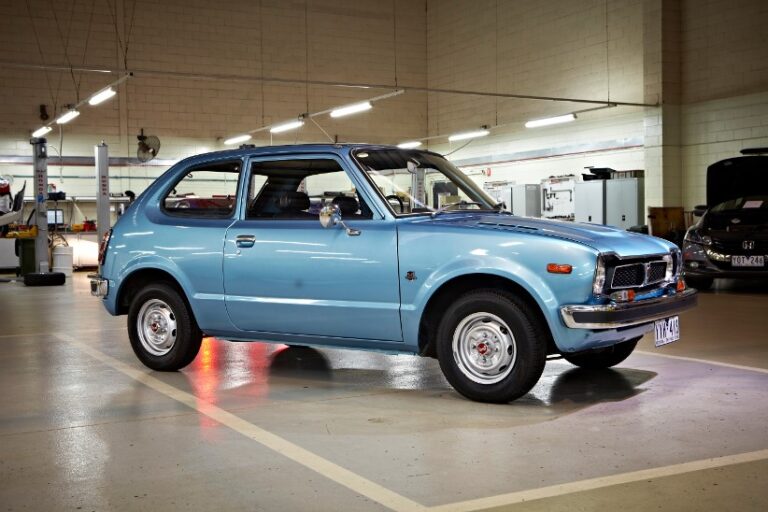A car that is a motoring revolution has just gone on sale in Australia. It isn’t a revolution because it is so startlingly different in design or specification but simply because it is so damned good, so remarkably cheap and has such a wide appeal to buyers of all ages, sex and type. The car is the Honda Civic. (Wheels, May, 1973)
Although those words were written and published 44 years ago when the original Honda Civic was launched in Australia, they could just as easily have been written now, in May 2017, about the all-new 10th generation Honda Civic hatch.

Here is a look back at the original Honda Civic and how it compares to the all-new 2017 Honda Civic hatch, to see just how far Honda’s iconic Civic nameplate has come…
Power – it’s all relative
Honda’s engineers have squeezed an amazing 127 kW of power and 220 Nm of torque out of the all-new 1.5-litre VTEC Turbo engine, while even the proven 1.8-litre engine develops 104 kW and 174 Nm. The original Civic? It produced 48.4 kW and 93 Nm from its smooth-running 1.2-litre (1169cc) four-cylinder engine.
Ready, Set, Go
No prizes for guessing that the 2017 Civic hatch would win a 0-100 km/h sprint. Independently tested at around 9.2 seconds over that distance, it is more than four seconds quicker than the original 1973 Civic, which recorded a 0-60 mph time of 13.7 seconds. To be fair though, the 1973 Civic was considered very capable at the time among its contemporaries such as the Datsun 1200, Ford Escort, Mazda 1300 and Toyota Corolla.
Mod cons – For or Against?
We can all be a little sensitive about our weight. Not so the 1973 Civic, which tipped the scales at a lightweight 657 kg. The 2017 Civic hatch weighs in at nearly double that figure at 1289 kg, although it’s still considered light by modern standards. But you can put that weight down to the highly rigid body, comprehensive safety features, premium interior appointments, advanced technologies… the list goes on.
Fuel to take you far
The 1973 Civic had a 38-litre fuel tank – impressive for its day but not as impressive as the all-new Civic hatch. Courtesy of its 47-litre fuel tank and outstanding fuel efficiency, the 2017 Civic hatch provides peace-of-mind when it comes to those weekend escapes, with a range of over 700 km ensuring that you don’t spend too much of your time at the fuel bowser.
Hip pocket savings
The 1973 Civic was astonishingly frugal for its time, achieving around 7.5 L/100km. Even more astonishing is that the bigger, more comfortable, higher-performing and safer 2017 Civic with 1.5-litre VTEC Turbo engine achieves a fuel consumption figure of just 6.1 L/100km. So despite almost double the weight, the modern Civic still beats the original for fuel efficiency.
Space – the final frontier
But it’s not all about power and performance, let’s take a look at boot space. And guess what? The 2017 Civic hatch cinches it, packing a massive 414-litres with the rear seats up, making it one of the best on the small car market for luggage space. The 1973 Civic? 160-litres – again, better than some of its contemporaries, but not in the same league as the latest Civic hatch.
More bang for your buck
The 1973 Civic had a top speed of around 145 km/h. Today’s Civic hatch? It’s academic really, but it could easily outpace the original car. But today’s young customer also looks for connectivity, fuel efficiency, key features, quality, reliability and ultimately, price, before deciding on their new car.
What price for glory?
In 1973 the Civic 3-door with Hondamatic (automatic) transmission cost $2,469. In 2016, that equates to $22,437 (CPI* adjusted). The 2017 Honda Civic VTi hatch has a MLP^ of $22,390, which makes today’s car even better value for money than the original, despite the long list of design, performance, quality, safety and technology equipment and improvements it delivers. Standard equipment on the 1973 Civic extended to items such as fully-reclining bucket seats, a trip meter and a laminated windscreen.
* Inflation calculator courtesy of Reserve Bank of Australia
^ Manufacturer’s List Price (MLP) excludes Dealer Delivery and statutory charges






